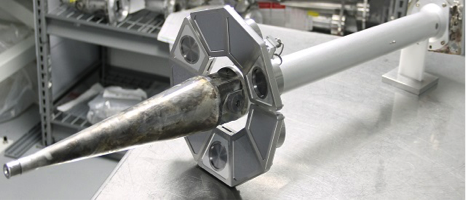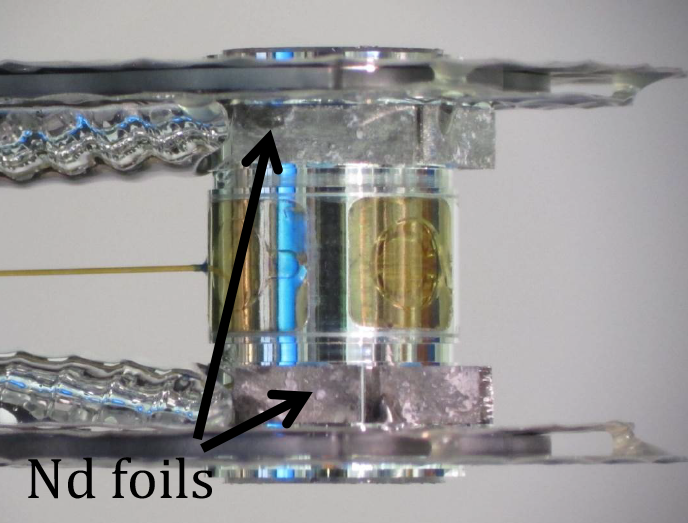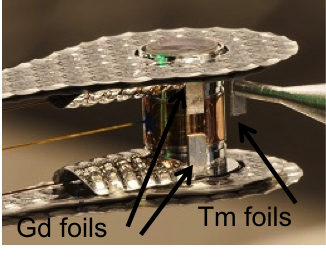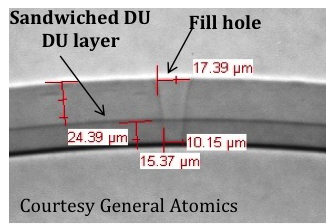Dawn Shaughnessy (13-ERD-036)
Abstract
Our goal with this project was to develop experimental platforms at Livermore's National Ignition Facility (NIF) for measuring neutron capture reactions in a high-energy-density plasma environment. Neutron capture cross-sections at kiloelectronvolt temperatures are important for interpretation of radiochemical data in nuclear forensics and stockpile stewardship, yet they cannot be directly measured at traditional neutron facilities. The ability to collect solid debris needed to be improved to measure nuclear cross sections at NIF, and target materials had to be incorporated into the target assembly for activation, collection, and subsequent analysis. Increased debris collection capabilities were established by adding additional solid radiochemistry diagnostics to the diagnostic instrument manipulator (DIM) 90-315 and by deploying the vast area detection for experimental radiochemistry (VADER) large-area collector on DIM 90-78. The new solid radiochemistry collectors cover a total of 1% of the 4π solid angle. Two dedicated shots were fielded with 0.5 to 1.0-mm-thick rare earth foils attached to the outside of the hohlraum of indirect-drive exploding-pusher capsules to evaluate debris distribution in the chamber. The indirect-drive exploding-pusher platform provides a clean source of 14-MeV neutrons without lower-energy neutrons. The debris from the rare earth foils was highly directional in that only the material on the same line of site was observed on any given collector with no debris observed on the polar diagnostic instrument manipulator. In addition, collection was enhanced over a typical hohlraum collection without the additional foils. A third shot consisting of a capsule with a layer of uranium-238 added to the plastic shell was fielded. Outer surface roughness of the capsule resulted in neutron yield degradation, but it was still sufficient to observe both fission fragments and activation products on the collectors. That was the first time a doped capsule was used as a target for a radiochemical measurement at NIF. Future experiments using these new capabilities will require improved capsule fabrication.
Background and Research Objectives
The nuclear reactions at the heart of nuclear forensics, stockpile stewardship, and nuclear astrophysics all take place in high-energy-density plasmas with temperatures in the kiloelectronvolt (>106 K) range. The approach used to date to obtain kiloelectronvolt-neutron capture cross-sections in the plasma has been to employ statistical reaction modeling. However, results from Kaeppeler et al. show that kiloelectronvolt-neutron capture cross-sections determined using state-of-the-art reaction models have uncertainties greater than 100 to 300%,1 making direct measurement the only viable approach. Unfortunately, since the cessation of nuclear testing, there has been a lack of settings where neutron activation reactions can be experimentally studied in a high-energy-density plasma in this energy range. Sensitivity studies performed by Mustafa et al. have shown that uncertainties in activation cross-sections for specific radiochemical detectors can lead to uncertainties up to approximately 20% in the corresponding calculated isotope ratio.2 There is an effort to reduce uncertainties associated with interpretation of radiochemical data for stockpile stewardship and post-detonation nuclear forensic diagnostic applications. To successfully evaluate results from analysis of radiochemical data, we must measure neutron capture and activation cross-sections that are currently lacking from evaluated data sets (particularly from excited nuclear states) to constrain the calculations used for their subsequent interpretation.
Recent results from Shaughnessy et al. on solid debris post-shot radiochemistry at NIF have provided the first strong evidence that an adjustable quantity of kiloelectronvolt-neutrons are consistently produced at NIF in high compression deuterium–tritium capsules through the observation of radioactive gold isotopes produced via neutron interactions in the hohlraum.3 In addition to reactions on the hohlraum and surrounding assembly, collection foils mounted near the center of the NIF chamber have shown an activation pattern indicative of a hybrid neutron spectrum that includes both high- and low-energy components that could be of significant interest to national security applications. These results have opened the door to "ride-along" debris collection measurements of neutron capture cross-sections for nuclear forensic materials. Recent work by Hoffman et al. shows that radiochemical signatures in high-energy-density plasmas are highly dependent on (neutron, gamma) cross-sections in the kiloelectronvolt-energy region on unstable nuclei.4 Such quantities cannot be measured via activation measurements in conventional accelerator-based experiments, but are ideally suited to NIF-based measurements. The NIF offers a unique opportunity to measure these kiloelectronvolt-neutron capture cross-sections that cannot be produced at any other facility in the world.
The state-of-the-art facility for kiloelectronvolt-neutron capture cross-sections measurements is the Detector for Advanced Neutron Capture Experiments (DANCE) at Los Alamos National Laboratory. The method used at DANCE is to relate the prompt gamma-flux from neutron capture on a small (10-mg) target to the capture cross-section. This approach suffers from a dependence on a continuum gamma-ray model for interpretation of the data. In contrast, a hohlraum-based NIF activation measurement does not include this systematic uncertainty and provides a signal (based on a 1014 neutron yield at NIF) that is 1.3 to 25 times greater than the signal from a one-day-long DANCE target run.
A goal of this project was to develop experimental platforms for measuring neutron capture cross-sections on elements relevant to nuclear forensics, stockpile stewardship, and nuclear astrophysics by adding materials to either the NIF capsule or the surrounding hohlraum and subsequently collecting the resultant nuclear reaction products via the solid debris diagnostic for post-shot analysis. This project built upon existing solid radiochemistry debris diagnostic at NIF to perform measurements on cryogenic deuterium–tritium shots. The objective was to incorporate nuclear reaction target materials into the hohlraum and the inner part of the NIF capsule ablator. During a NIF implosion, 14-MeV neutrons are produced via the deuterium–tritium fusion process. Any target material incorporated into the NIF capsule assembly will see a combination of these 14-MeV neutrons, and lower energy neutrons in the kiloelectronvolt range that have scattered off of the deuterium–tritium fuel. Neutron activation with 14-MeV neutrons and neutron capture with lower-energy neutrons will occur in the target material, which will then be incorporated into the plasma following the capsule explosion. The plasma will also contain activated material that surrounded the capsule, which includes the aluminum thermomechanical package and large amounts of copper, stainless steel, and other assorted elements. All of this activated debris is collected via solid radiochemistry and subsequently removed from the chamber for analysis through a combination of radiochemical and analytical techniques, including gamma spectroscopy, surface leaching, mass spectroscopy, and microscopy. The overall goal of this project was to develop at NIF the world’s first facility capable of measuring neutron-induced nuclear activation cross-sections in a plasma environment. In order to successfully accomplish this, the solid radiochemistry collectors were optimized for improved debris collection, methods for incorporating target material into the NIF capsule assembly and surrounding hohlraum were developed, and three dedicated shots were used to establish the methodology for measuring neutron capture cross-sections on thulium, gadolinium, neodymium, and uranium as initial test cases.
Scientific Approach and Accomplishments
The first requirement to establishing neutron reaction measurements at NIF was to increase the efficiency of collection for solid debris. The solid radiochemistry collectors consist of four 5-cm-diameter metal or graphite foils fielded on one of the DIMs located either on the equator or north pole (coordinates 90-78 and 0-0, respectively) at a distance 50 cm from target chamber center. Figure 1 shows the end of a DIM snout with four solid radiochemistry foils attached. When both the polar and equatorial DIMs are fielded, a total of eight solid radiochemistry collectors are fielded with a total collection area of 0.3% of the total 4π solid angle. To improve the total collection efficiency, we fielded additional collectors on DIM 90-315 (also equatorial) and a large-area collector was created for DIM 90-78. The DIM 90-315 is typically configured for deuterium–tritium shots with an air box that is part of the neutron imaging system. A bracket was designed that attached to the air box, with an additional four standard solid radiochemistry holders, increasing the total collection area to 0.5% of 4π when all 12 positions are used.
Figure 1. Solid radiochemistry collectors fielded on the end of the DIM (90-78) snout. The four collectors are each 5-cm in diameter and are fielded 50 cm from the capsule. The collectors can be either metal or graphite foils.
In addition, the VADER was created to replace the configuration of four solid radiochemistry collectors on DIM 90-78.5 VADER can be configured with either trapezoid-shaped metal or graphite foils, or with the standard 5-cm-diameter collectors. When fielded with a full complement of nine trapezoids, VADER has a surface area that is 5.7 times greater than the four solid radiochemistry holders. When VADER is fielded with the solid radiochemistry collectors on DIMs 90-315 and 0-0, the total collection efficiency is 1% of the 4π solid angle. Figure 2 shows the VADER large-area collector mounted onto the end of a DIM snout.
Figure 2. The vast area detection for experimental radiochemistry (VADER) large-area collector mounted on the end of the snout on DIM 90-78. The VADER has a collection area over five times greater than the configuration of the four solid-radiochemistry collectors shown in Figure 1.
Three dedicated shots were awarded during the last year of this project that either had target materials added to the outside of the hohlraum thermomechanical package, or material incorporated into the capsule ablator. The first shot, N141130, consisted of 0.5-mm-thick foils of natural thulium and neodymium attached to the thermomechanical package that surrounds the gold hohlraum as shown in Figure 3. The second shot, N150226, used 1-mm thick foils, and also had gadolinium in addition to thulium and neodymium shown in Figure 4. Both shots used an indirect-drive exploding-pusher capsule, which consisted of a 120-mm-thick plastic capsule shell with a 50:50 deuterium–tritium gas fill. The neutron yield in each case was about 514. Shot N141130 had a configuration of 12 solid-radiochemistry collectors, while N150226 used VADER on DIM 90-78.
The results from both shots indicated that the debris from the foils attached to the thermomechanical package was very directional, with enhanced collection observed on the equatorial DIMs greater than what was expected based on solid angle alone. This was in contrast to the polar DIM, which had almost no post-shot debris on the collectors. In addition, the hohlraum debris appears to move away from target chamber center isotropically with almost no mixing between the various components. Table 1 shows the fractional recovery of the different materials fielded in N141130 based on collection position. The VADER also showed enhanced collection of the gadolinium foils that were in line with DIM 90-78. Greater than 6% of the ingoing gadolinium was collected on VADER while almost no debris from thulium and neodymium foils facing the other DIMs was observed. The results from these two shots indicate that experiments can be performed in a ride-along mode where materials are placed on the outside of the hohlraum thermomechanical package regardless of the capsule that is used. As long as the neutron yield is high enough to measure the resultant nuclear reaction products, the debris can be collected with high enough efficiency to measure cross sections on a variety of different shot types without affecting the primary goals of the experiment.
Table 1. Fraction of material in percent collected in shot N141130 as a function of the location of the solid radiochemistry collectors.
| Material | DIM 0-0 | DIM 90-78 | DIM 90-315 |
|---|---|---|---|
| Neodymium | ≤ 10-5 % | 0.06 – 0.26 % | ≤ 5 x 10-5 % |
| Thulium | ≤ 10-5 % | ≤ 1 x 10-5 % | 0.04 – 0.17 % |
The third and final shot, N150907, consisted of a plastic symmetry capsule with a single layer of uranium-238 sputtered onto the first 10 mm of the shell, as shown in Figure 5. The outer surface of the shell unfortunately had a roughness that was not to specification, which resulted in yield degradation. The final neutron yield was high enough to observe both fission fragments and the 238U(n,2n)237U activation products on the equatorial debris collectors. This was the first time that a capsule was doped with a radiochemically active target, which was then collected via solid debris collection. The issues with capsule fabrication will need to be addressed in the future to provide higher quality capsules, but the results indicate that even a small amount of target atoms can produce enough signal to measure nuclear reactions in a NIF capsule.
Figure 5. Micrograph of a test capsule for shot N150907. The capsule is plastic. At 15 μm from the inner surface, a single layer of uranium-238 has been sputtered onto the plastic resulting in a sandwiched layer. The final capsule used in the shot had a uranium-238 layer at 10 μm.
Impact on Mission
Conclusion
We developed platforms for measuring neutron reactions at NIF for nuclear forensics, stockpile stewardship, and nuclear astrophysics. Improved collection efficiency for solid debris was obtained by adding collectors to DIM 90-315 and through the deployment of the VADER large-area collector. Initial shots with rare earth foils added to the outside of the hohlraum thermomechanical package indicated that the hohlraum debris is highly directional, with almost no mixing occurring at target chamber center. This implies that measurements can be made as ride-alongs to other NIF shots. The first doped capsule was prepared by sputtering a single layer of uranium-238 onto the first 10 mm of a plastic capsule. Although the yield was degraded, there was enough signal to observe fission fragments and activation products on the solid radiochemistry collectors. In the future, the capsule fabrication for doped capsules must be improved so that higher neutron yields can be accomplished. By demonstrating the ability to perform nuclear science reactions on NIF, we have also introduced the external nuclear physics community to the possibility of performing astrophysically relevant experiments using the NIF platform. A collaboration with the University of Notre Dame, Indiana, has been established to plan for astrophysics experiments at NIF in the future, based on the platforms developed under this project. Additional shots will be requested in the future both for Laboratory missions and for discovery science.References
- Kaeppeler, F., et al., “The s process: Nuclear physics, stellar models, and observations.” Rev. Mod. Phys. 83, 157 (2011).
- Mustafa, M. G., and R. D. Hoffman, Personal communication. (2011).
- Shaughnessy, D., et al., “Radiochemical determination of Inertial Confinement Fusion capsule compression at the National Ignition Facility.” Rev. Sci. Instrum. 85, 063508 (2014). LLNL-JRNL-647705. http://dx.doi.org/10.1063/1.4883186
- Hoffman, R. D., presentation to the Nuclear Explosives Design Physics Conference, Los Alamos, NM, Oct. 2011.
- Galbraith, J., et al., “Vast area detection for experimental radiochemistry (VADER) at the National Ignition Facility.” Target Diagnostics Physics and Engineering for Inertial Confinement Fusion IV, Proc. of SPIE 9591, 95910G (2015). LLNL-CONF-673994.
Publications and Presentations
- Galbraith, J., et al., “Vast area detection for experimental radiochemistry (VADER) at the National Ignition Facility.” Target Diagnostics Physics and Engineering for Inertial Confinement Fusion IV, Proc. Of SPIE 9591, 95910G (2015). LLNL-CONF-673994.
- Gharibyan, N., et al., "First fission yield measurements at the National Ignition Facility: 14-MeV neutron fission of U-238." J. Radioanal. Nucl. Ch. 303, 1335 (2015). LLNL-PROC-644168. http://dx.doi.org/10.1007/s10967-014-3474-6
- Gharibyan, N., et al., Fission yield measurements of U-238. 7th Bi-Annual Joint AWE/LANL/LLNL Nuclear Data Workshop, Livermore, CA, Apr. 2014. LLNL-PRES-643944.
- Gharibyan, N., et al., Fission yields and activation products. High Energy Density Experiments Supporting National Security Workshop, Livermore, CA, Feb. 2014. LLNL-PRES-649732.
- Gharibyan, N., et al., "Production and separation of carrier-free Be-7." Appl. Radiat. Isot. 107,199 (2015). LLNL-JRNL-673455.
- Gharibyan, N., et al., Radiochemical measurements of neutron capture and isomeric data at the NIF. AAAS 2014 Ann. Mtg., Chicago, IL, Feb. 13–17, 2014. LLNL-PRES-649935.
- Gharibyan, N., et al., Radiochemical measurements of neutron capture and isomeric data at the NIF. P(ND)2-2 2nd Intl. Workshop on Perspectives on Nuclear Data for the Next Decade, Bruyeres-le-Chatel, France, Oct. 14–17, 2014. LLNL-PRES-662204.
- Gharibyan, N., et al., 2015. Radiochemistry in support of post-detonation nuclear forensics at the National Ignition Facility. Methods and Applications of Radioanalytical Chemistry, Kailua-Kona, HI, Apr. 12–17, 2015. LLNL-ABS-665366.
- Gharibyan, N., et al., Radiochemistry in support of post-detonation nuclear forensics at the National Ignition Facility. MARC X Conference, Kailua-Kona, HI, Apr. 12–17, 2015. LLNL-PRES-669644.
- Grant, P., et al., “Anomalous radiochemical recovery of post-detonation gold residues at the National Ignition Facility.” J. Radioanal. Nucl. Chem. 303, 1851 (2014). LLNL-JRNL-655940. http://dx.doi.org/10.1007/s10967-014-3626-8
- Hagmann, C., et al., "Note: Radiochemical measurement of fuel and ablator areal densities in cryogenic implosions at the National Ignition Facility." Rev. Sci. Instrum. 86, 076105 (2015). LLNL-JRNL-653874. http://dx.doi.org/10.1063/1.4926743
- Shaughnessy, D. A., Applications for nuclear forensics at the National Ignition Facility. 249th American Chemical Society National Mtg., Denver, CO, Mar. 22–26, 2015. LLNL-ABS-663208.
- Shaughnessy, D. A. et al., Nuclear science research with dynamic high energy density plasmas at NIF. Inertial Fusion Sciences and Applications, Seattle, WA, Sept. 25, 2015. LLNL-PRES-677395.
- Shaughnessy, D., et al., “Radiochemical determination of Inertial Confinement Fusion capsule compression at the National Ignition Facility.” Rev. Sci. Instrum. 85, 063508 (2014). LLNL-JRNL-647705. http://dx.doi.org/10.1063/1.4883186
- Shaughnessy, D. A., et al., Radiochemical measurements at the National Ignition Facility. Radiobioassay and Radiochemical Measurements Conference, Rohnert Park, CA, Oct. 21–25, 2013. LLNL-ABS-647474.
- Shaughnessy, D. A., et al., Radiochemical measurements of neutron reaction products at the National Ignition Facility. Intl. Conf. Application of Accelerators in Research and Industry, San Antonio, TX, May 25–30, 2014. LLNL-ABS-651213.
- Shaughnessy, D. A., et al., Radiochemical measurements of neutron capture products at the National Ignition Facility. Nuclear Physics Processes in Dynamic High Energy Plasmas, London, United Kingdom, Oct. 15–17, 2012. LLNL-ABS-573456.










